The ancients did not go to the doctors with heart problems. The most helpful were ... witches. The illustration shows a fragment of John William Waterhouse's painting "The Sorceress".
I used to be able to five times, or even nine,
one time today just during the whole night,
and a short while (Aphrodite, save me!),
because they are half out of power, scoundrel.
About Old Age, what next ?! Old age, what will be ?!
If it's weak now, well then ?!
In this way, Philodemus of Gadara (2nd-1st century BC) lamented the indisposition that relentlessly encountered the elderly. These problems with the potency of the hero of the epigram led him perhaps to a familiar doctor, or - more likely - to a specialist in erotic magic. Because antiquity is a time when various occult practices were commonplace.
Happy Phalluses
While ancient scholars argued over the scientific nature of erection and male orgasm (some considered, for example, that when an erection fills a penis with air, which then pushes the sperm outward), one thing remained the same: the common people's belief in the magical power of phallus images .
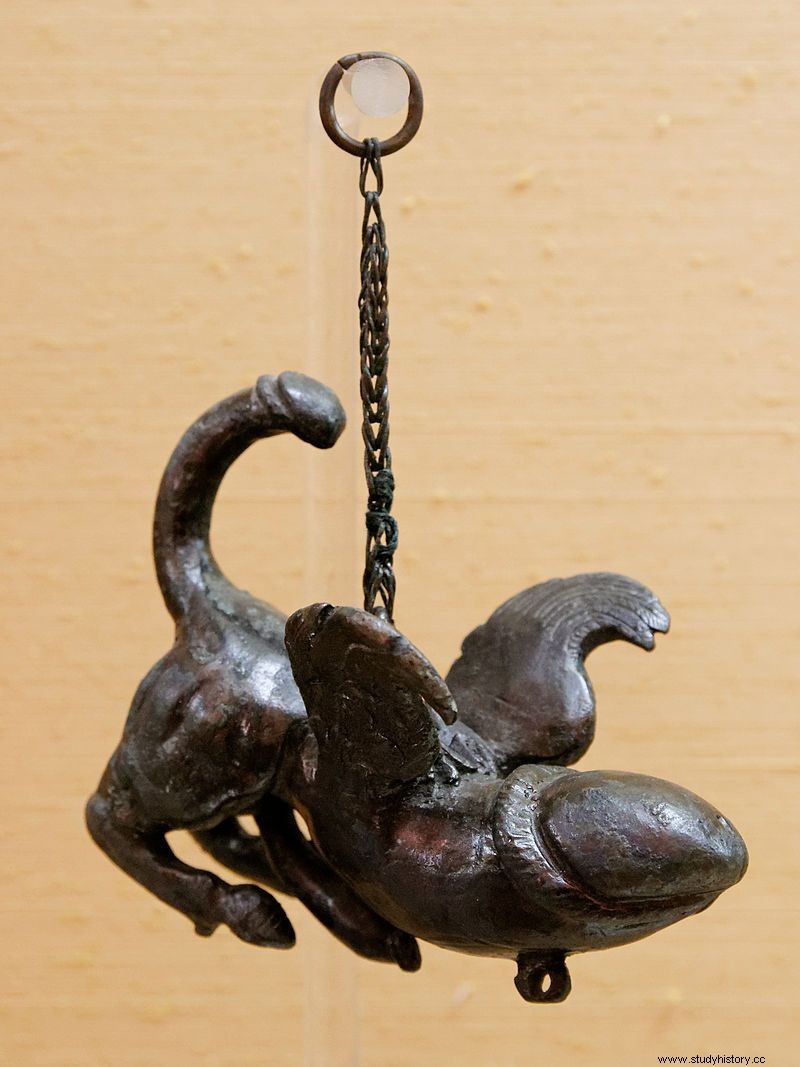
In ancient Rome, amulets-images of a phallus (one found in Pompeii in the photo) were the order of the day. They were believed to provide protection and prosperity.
Penises were accentuated, for example, in the Greek herms - square poles topped with a male head. The erect limbs were obviously at the correct height and looked quite naturalistic. They were supposed to avert misfortunes. When in 415 BCE there was a profanation of these herms in Athens, or, to be precise, the destruction of phalluses, a great political scandal broke out, although this sacrilege was probably just a freak of drunken youngsters.
Similarly, images of phalluses were placed on the thresholds of Roman houses to protect the inhabitants from the "evil eye" and bring good luck. They flexed proudly - and sometimes even artistically squirted their semen! - on stone reliefs from Egypt to Britain, in villas and military forts. During the holidays devoted to fertility deities called liberals (March 17), the Romans circled the villages with carts with wine, cakes and just phalluses. At the end of the holiday, respected matrons put a wreath on the symbolic great member.
Also in the Roman Colosseum, scientists, during the restoration works, noticed a few years ago an overlooked image from the 3rd century CE, showing an erect penis. Ancient fans used to draw such pieces on the walls in order to bring happiness to their favorites - for example gladiators, whose victory they put money on.
Help the idols
A voracious god who came to Rome from the Hellespont:Priap was also to help mortals. Presented in the form of a man with a huge erection, he used to promote fertility, bring happiness and counteract evil. It was believed that Priap statues placed in shops and gardens would deter potential thieves. They were accompanied by inscriptions of threats against the robbers, for example:"If a woman, a man or a boy goes against me, let the woman prepare her cunt, the man his mouth, and the boy his ass ”.

This article was written during the author's work on the book "Ages of shamelessness. Sex and erotica in antiquity ”(CiekawostkiHistoryczne.pl 2018).
Phallic or priapic shapes had countless amulets (called fascinus or fascinum ), lamps, bells, rings, ornaments for women and children, etc. For example, an inscription with male genitalia and the words "Happiness lives here" once stood on an arch above a baker in Pompeii, and after its discovery in modern times, someone oversensitive transferred it to "Secret Cabinet" at the National Museum of Naples. There, however, for a long time avoided directly naming what they are and what are represented by similar "secret" inscriptions and jewelry. They emphasized their magical meaning that they "turned the spells away", but avoided sexual connotations…. Was it a sense of shame being an obstacle?
As sexually active as Priap was the goat-legged patron of the shepherds Pan (according to Greek mythology), also known as the Roman Faun. It is well presented by the shocking (today, but not then!) Antique sculpture from the "Secret Cabinet", showing a horned idol copulating with a goat .
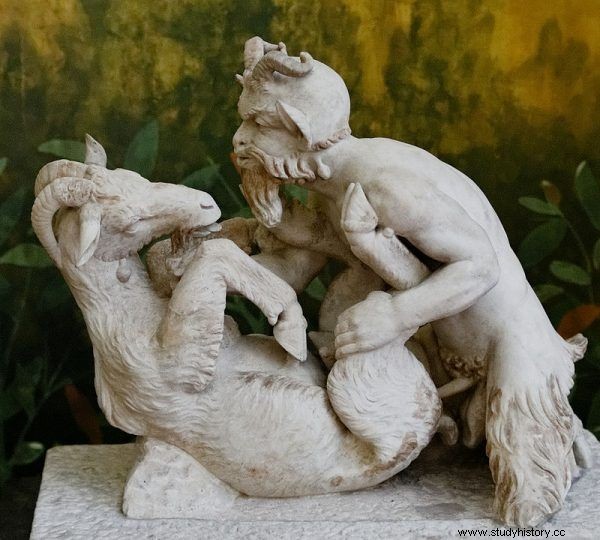
Faunus was in Roman mythology the horned god of the forest, identified with the Greek Lord. Its main task was to give fertility. The illustration shows the sculpture found in Herculaneum "Faun copulating with a goat".
In Rome, the Lord promoted fertility. Especially during lupercalia - holidays celebrated on February 14-15, i.e. on our Valentine's Day. The Romans mentioned that day, among others, the "she-wolf" Akka Larencja, who not only fed Romulus and Remus, but also looked after the Faun. In lupercalie, the half-naked priests of this wonder ran around the streets threatening men with knives, and whipping women with whips. Their impact was not so much painful as it was happy to heal women from infertility.
There have been many superstitions about sex. Omens such as ringing in the ears, the creaking of the bed, the flashing of the lamp or even sneezing (not on the water!) Were considered significant for the "deeds of Aphrodite". Of course, courtesans specialized in translating these phenomena - to the greatest possible advantage for themselves.
Ancient erotic dreams also required explanations for the ancients. Artemidor, a philosopher from the 2nd century CE, interpreted them in a unique way. It was a good sign for him to dream that you were making love with your wife, mistress or your own slaves (as long as you were not the passive party there!) . Why? Because it was a promise of continued success and peaceful enjoyment of one's goods. Dreaming of having sex with a prostitute was less favorable. Losing sperm with her meant losing in real life - and not only sperm.
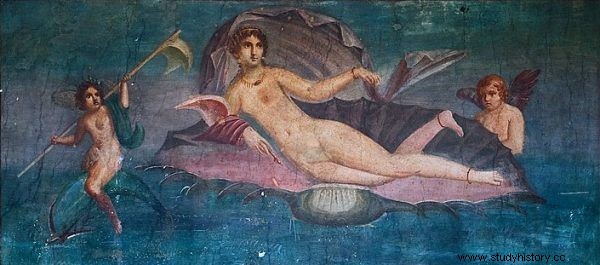
Who to turn to with a request for happiness in love, if not the goddess who watches over those in love? The illustration shows a fragment of an ancient fresco discovered in Pompeii, depicting Aphrodite.
Living amidst such superstitions, the Greeks and Romans were quite willing to use magic for sex and love. So they reached for amulets and other magical gadgets. The goddess Hera herself gave them an example, when in "The Iliad" - in order to refresh her sexual relations with Zeus - she was given a special belt (breastbone) from Aphrodite.
It contains all charms, all charms,
Love, lust, lovers talking and moaning,
Sweet voices, secretive words
Hearts that are tender, even tender-guarded.
"Take, say, this lane of road, that's where everything fits
What delights the mind and caresses the heart.
He will do the invincible magic,
That somehow you will end your intentions ".
One-third of the surviving ancient magic papyri and defixiones are also involved in sex. - tablets (usually lead, but also made of other metals, stone, wood and clay) with spells.
Sorcery verses
Through special formulas and invocations to supernatural forces, attempts were made to punish unbelievers or would-be lovers, or to win someone's love. There was room for jealousy and revenge in them. From Spain, North Africa, the Middle East or Greece, it flowed to the mages preparing defixiones - for an appropriate fee, of course - a whole avalanche of pleas and complaints:"May Quintula never meet Fortunalis again"; "Let it burn and go mad with desire and love for me, let the soul and heart of Sextilius, son of Dionysia, burn with desire and love for me"; "Let her be submissive to me like a slave", "That they may not lie together, join together, go to bed together, eat together, drink together."
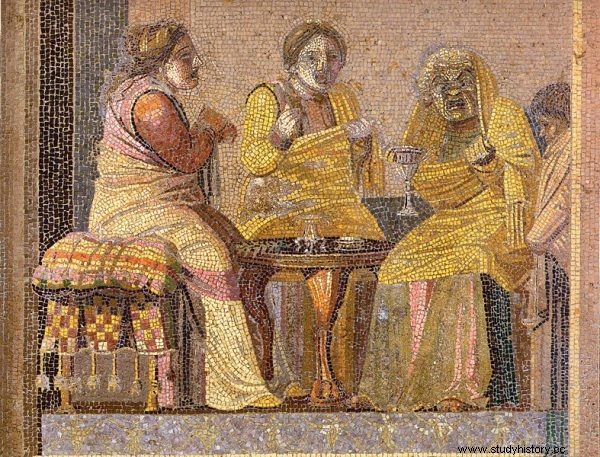
Ancient witches had formulas and spells for just about anything. Sometimes they prepared specific things for specific ailments. But not only. They could also order a curse on an uncomfortable competitor. The illustration shows a fragment of a Pompeian fresco.
Defixiones they were very naturalistic in showing the life and desires of the ancients. The historian of antiquity, Paweł Janiszewski, writes:
Tablets often tell a person to "cool" towards his current lover, "get cold" in feelings like that piece of lead or a corpse with a plate placed on it. Often a spell is cast on a rival so that he cannot maintain sexual relations. These are the spells that prevent you from getting an erection. One of the tablets calls for a young man to "turn away" from another man:eyes, mouth, face, breasts, abdomen, penis, buttocks, soul and whole body. Of course, to "turn" them to another. (…)
Another pad brings a spell so that the principal's girlfriend cannot have intercourse "from the front", "from behind" or "suck" anyone else but him . Often, the text dictates that the named person should get rid of indifference, that desire overwhelm the next - listed in detail - members of his body, so that he cannot sleep, eat, walk, etc., only "lashed with a whip of passion" run to the person ordering the plate .
Defixiones was used, of course, not only for erotic purposes. For example, in the Roman baths in the British city of Bath (Aquae Sulis), dozens of lead strips filled with curses were found to hit ... the robbers prowling in these thermae.
Their example shows that those who ordered the plates could be cruel to the people they targeted (for example:"As long as a slave or free, who is silent, although he has stolen a ring or witnessed the theft, damn his blood, eyes and whole body, and the guts are eaten out "). Also in the case of love magic, the means were not chosen - a thin line separated white magic from black magic, which, with the help of demons or even human sacrifice, was supposed to bring misfortune to enemies or rivals.
Today, when we see ancient wax figures used for witchcraft, we associate them with the bloody rites of Afro-Caribbean voodoo. Those from Greece and Rome were also burned or pierced with needles - not, however, to kill someone, but to make the person who was the target of a magical rite susceptible to the wishes of the charming (malleable wax) or thinking only about him or her.
Magic potions for making the sexual life of your competitors unpleasant are just as unpleasant. In the most "civilized" way, it was possible to induce impotence in a rival by giving him wine with a barbel, one of the species of freshwater fish. If this did not work, the witches operated with a man's urine-drowned lizard or anoint his penis with a numb brain - literally electric fish. The question is who should apply it and how ?!
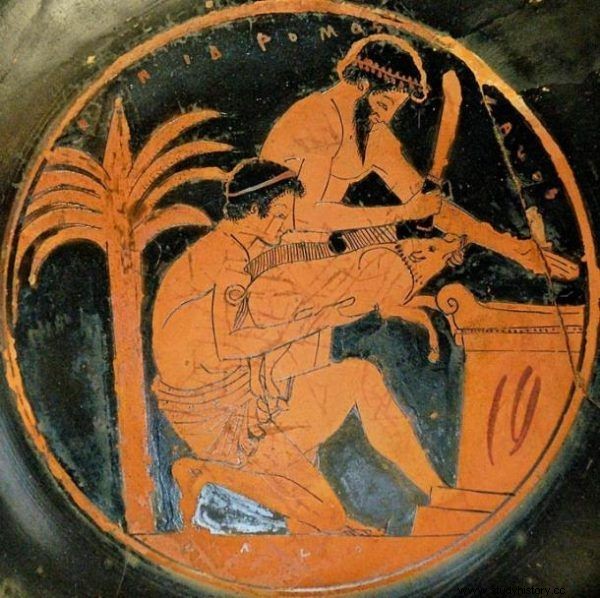
Some ancient ways to love evoke laughter, others to dread, and some to real disgust ... The illustration shows a painting of a red-figure cup depicting one of the ancient rituals.
In turn, the ideal way to seduce someone was to squash on your private parts ... a tick from a dead dog. When the pick-up was successful, all you had to do was make sure you had a good sex. For this purpose, the genitals had to be lubricated with carrot juice or ... excrement of the sparrow mixed with honey, as advised by a magical papyrus of the 3rd century C.E.
Women had a choice of a whole range of preparations with lovage, thanks to which they could ensnare men. In order to regain the unfaithful lover, they prepared a cake made of unleavened flour, baked in a fire with thyme and laurel sprigs. Counteracting such and other preparations - if the man really wanted to protect himself from love spells - could be various antidotes:for example a tablet made of crushed root of an earthen gully.
End of witchcraft in the service of lust
It was all part of the sex business, which brought quite a lot of income. The cronies of Thessaly and Phrygia were considered particularly adept at witchcraft. It was enough that they had some object belonging to the target person (even a piece of robe, shoes, hair) and they could work wonders.
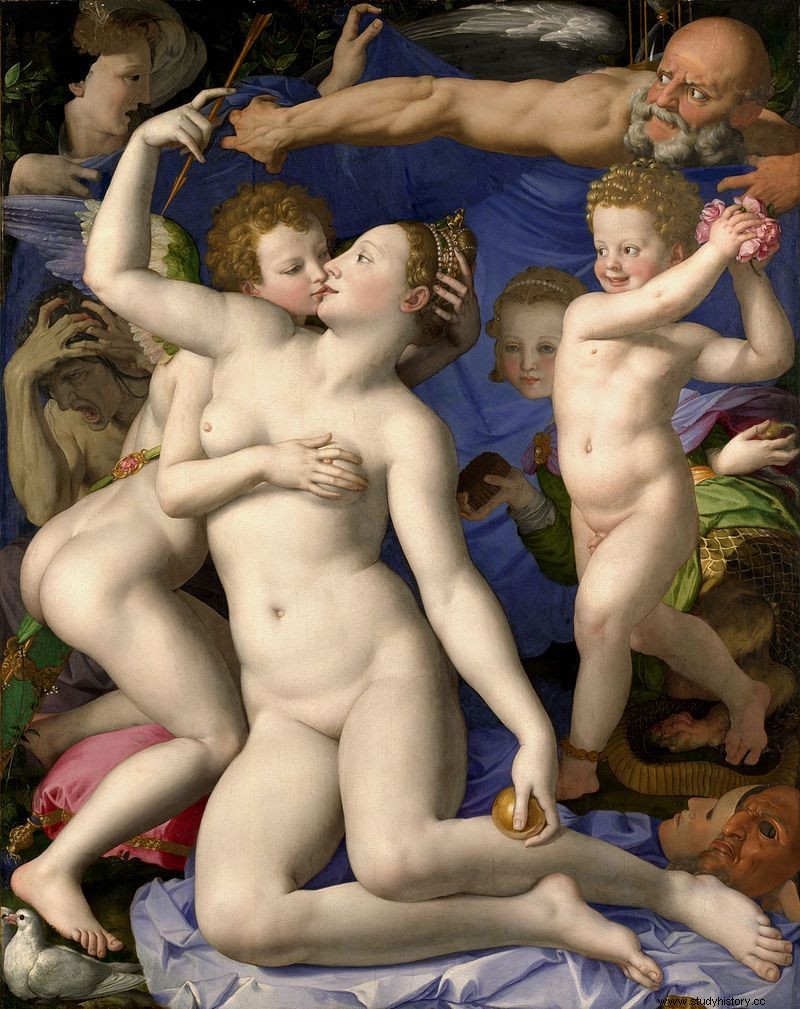
Real magic or ordinary sex business? While the customers of the "sorceresses of love" believed in their power, they often tricked naive lovers. Some people overpayed such spells with their lives ... In the illustration Bronzin's painting "Venus, Cupid and Time".
In Rome, the sages of Egypt and other countries of the Middle East also made a career. For centuries, the ancients trusted these fraudsters, although they knew that using their services could bring disastrous results. According to a story told by Aristotle, a hetera gave a loving young man a lovage, and the poor man - instead of getting excited - died . She was lucky not to be convicted. The judges decided that she did not want to kill her lover, but only to rekindle his weakening feeling.
More entertaining (but fictional) magical-erotic themes fill the famous ancient romance "Metamorphoses, or the Golden Donkey" of Apuleius, written in the middle of the 2nd century CE. However, they did not amuse Christian saintly men, for whom every witchcraft was suspect, let alone erotic magic! Therefore, Emperor Constantine the Great in the 4th century CE He emphasized that only magical practices that would heal or protect the crops from bad weather were allowed, and that witchcraft in the service of sexual desires was forbidden. The ages of shamelessness were ending then…
***
The text was created during the author's work on his latest book. " Ages of shame. Sex and erotica in antiquity ” .
